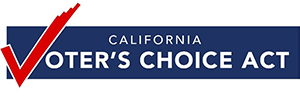Key elements of Voter’s Choice Act Elections Model

Vote-by-Mail Ballots
Every registered voter in participating counties would be delivered a ballot 28 days before Election Day.
Voters will have three ways to return their ballot:
1. Mail the ballot;
2. Drop the ballot in a secure county ballot drop box; or
3. Visit any vote center in the county.
Vote Centers
Traditional polling places will be replaced by vote centers. Voters will have the freedom to cast a ballot in-person at any vote center in their county instead of being tied to a single polling location. Vote centers look and feel like polling places, but provide additional modern features to make voting easy and convenient.
At any vote center in a participating county, a voter may:
- Vote in-person
- Drop off their ballot
- Get a replacement ballot
- Vote using an accessible voting machine
- Get help and voting material in multiple languages
- Register to vote or update their voter registration
Starting 10 days before the Election and through the Friday before Election Day, one vote center is required for every 50,000 registered voters. On Election Day and the Saturday, Sunday, and Monday leading up to Election Day, one vote center is required for every 10,000 registered voters.
Ballot Drop-Off Locations
Ballot drop-off locations provide voters with an additional way to return their ballot postage free.
Starting 28 days before Election Day there would be at least one drop-off location for every 15,000 registered voters.
Drop-off locations must be secure, accessible to voters with disabilities, and located as near as possible to public transportation routes.
Voter Education and Public Process for Adopting Vote Center Plans
Every county that adopts the Voter’s Choice Act model is required to draft and adopt a detailed plan through an open, public process.
In addition, counties are required to hold education workshops with community groups, including organizations that assist voters with disabilities and language minority communities.
Public Partnerships
The Secretary of State is working closely with community groups and election administrators to develop best practices and ensure a smooth transition to the Voter’s Choice Act for California voters.
The Secretary of State has convened an advisory taskforce of election experts, disability and language experts, and elections administrators to provide direction, input, and advice regarding the implementation of the Voter’s Choice Act.
The Secretary of State is also participating in a working group with the California Association of Clerks and Election Officials ( CACEO) to coordinate the technical, logistical, and legal requirements of the Voter’s Choice Act.
Additionally, the Secretary of State is working with community partners, like Voters Choice California, a network of civil rights and advocacy groups, to ensure broad public participation and outreach to California voters.
